Paper Menu >>
Journal Menu >>
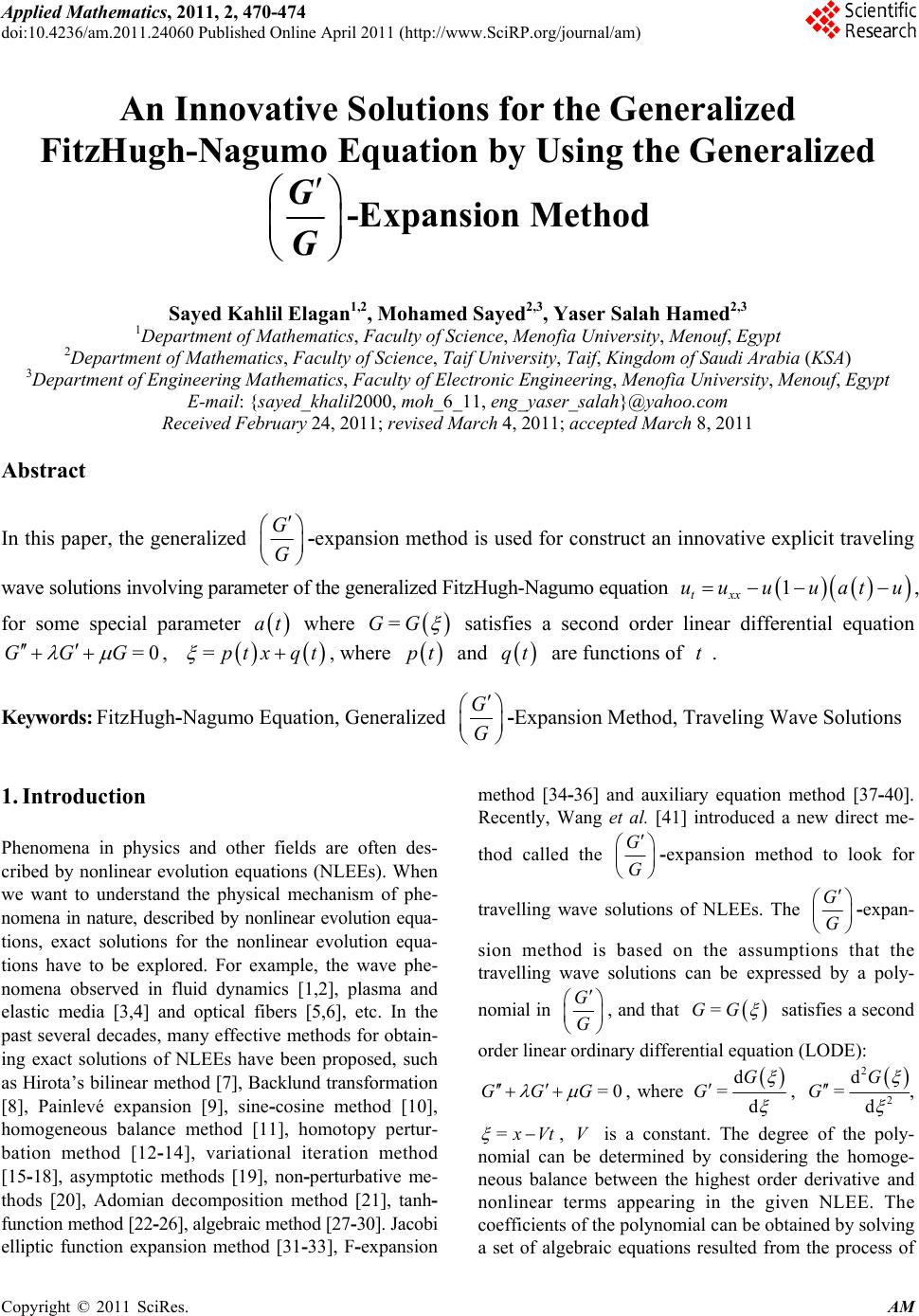 Applied Mathematics, 2011, 2, 470-474 doi:10.4236/am.2011.24060 Published Online April 2011 (http://www.SciRP.org/journal/am) Copyright © 2011 SciRes. AM An Innovative Solutions for the Generalized FitzHugh-Nagumo Equation by Using the Generalized G G-Expansion Method Sayed Kahlil Elagan1,2, Mohamed Sayed2,3, Yaser Salah Hamed2,3 1Department of Mat hem at ic s, Faculty of Science, Menofia University, Meno u f, Egypt 2Department of Mat hem at ic s, Faculty of Science, Taif University, Taif, Kingdom of Saudi Arabia (KSA) 3Department of Engi neering Mathemati cs , Faculty of Electronic Engineering, Menofia University, Men ouf, Egypt E-mail: {sayed_khalil2000, moh_6_11, eng_yaser_salah}@yahoo.com Received February 24, 201 1; revised Marc h 4, 2011; accepted March 8, 2011 Abstract In this paper, the generalized G G -expansion method is used for construct an innovative explicit traveling wave solutions involving parameter of the generalized FitzHugh-Nagumo equation 1 txx uu uuatu , for some special parameter at where =GG satisfies a second order linear differential equation =0GGG , = p tx qt , where p t and qt are functions of t. Keywords: FitzHugh-Nagumo Equation, Generalized G G -Expansion Method, Traveling Wave Solutions 1. Introduction Phenomena in physics and other fields are often des- cribed by nonlinear evolution equations (NLEEs). When we want to understand the physical mechanism of phe- nomena in nature, described by nonlinear evolution equa- tions, exact solutions for the nonlinear evolution equa- tions have to be explored. For example, the wave phe- nomena observed in fluid dynamics [1,2], plasma and elastic media [3,4] and optical fibers [5,6], etc. In the past several decades, many effective methods for obtain- ing exact solutions of NLEEs have been proposed, such as Hirota’s bilinear method [7], Backlund transfor mation [8], Painlevé expansion [9], sine-cosine method [10], homogeneous balance method [11], homotopy pertur- bation method [12-14], variational iteration method [15-18], asymptotic methods [19], non-perturbative me- thods [20], Adomian decomposition method [21], tanh- function method [22-26], algebraic method [27-30]. Jacobi elliptic function expansion method [31-33], F-expansion method [34-36] and auxiliary equation method [37-40]. Recently, Wang et al. [41] introduced a new direct me- thod called the G G -expansion method to look for travelling wave solutions of NLEEs. The G G -expan- sion method is based on the assumptions that the travelling wave solutions can be expressed by a poly- nomial in G G , and that =GG satisfies a se cond order linear ordinary differential equation (LODE): =0GGG , where d =d G G , 2 2 d =d G G , = x Vt , V is a constant. The degree of the poly- nomial can be determined by considering the homoge- neous balance between the highest order derivative and nonlinear terms appearing in the given NLEE. The coefficients of the polynomial can be obtained by solving a set of algebraic equations resulted from the process of 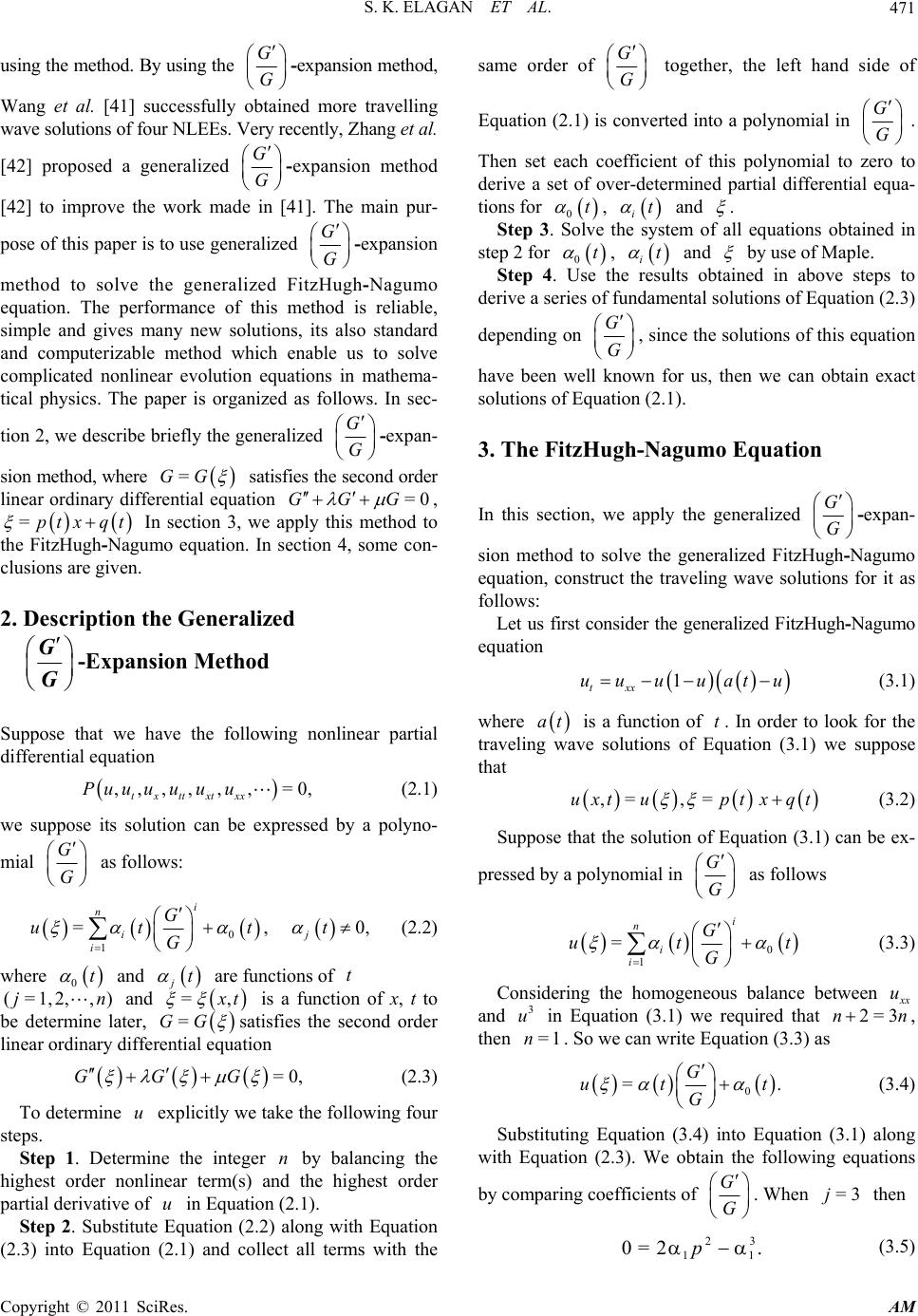 S. K. ELAGAN ET AL. Copyright © 2011 SciRes. AM 471 using the method. By using the G G -expansion method, Wang et al. [41] successfully obtained more travelling wave solutions of four NLEEs. Very recently, Zhang et al. [42] proposed a generalized G G -expansion method [42] to improve the work made in [41]. The main pur- pose of this paper is to use generalized G G -expansion method to solve the generalized FitzHugh-Nagumo equation. The performance of this method is reliable, simple and gives many new solutions, its also standard and computerizable method which enable us to solve complicated nonlinear evolution equations in mathema- tical physics. The paper is organized as follows. In sec- tion 2, we describe briefly the generalized G G -expan- sion method, where =GG satisfies the second order linear ordinary differential equation =0GGG , =ptx qt In section 3, we apply this method to the FitzHugh-Nagumo equation. In section 4, some con- clusions are given. 2. Description the Generalized G G-Expansion Method Suppose that we have the following nonlinear partial differential equation , ,, , , ,=0, txtt xt xx Puuu uuu (2.1) we suppose its solution can be expressed by a polyno- mial G G as follows: 0 1 = , 0, i n ij i G ut tt G (2.2) where 0 t and jt are functions of t (=1,2, ,)jn and =, x t is a function of x, t to be determine later, =GG satisfies the second order linear ordinary differential equatio n =0,GGG (2.3) To determine u explicitly we take the fo llowing four steps. Step 1. Determine the integer n by balancing the highest order nonlinear term(s) and the highest order partial derivative of u in Equation (2.1). Step 2. Substitute Equation (2.2) along with Equation (2.3) into Equation (2.1) and collect all terms with the same order of G G together, the left hand side of Equation (2.1) is converted into a polynomial in G G . Then set each coefficient of this polynomial to zero to derive a set of over-determined partial differential equa- tions for 0t , it and . Step 3. Solve the system of all equations obtained in step 2 for 0t , it and by use of Maple. Step 4. Use the results obtained in above steps to derive a series of f undamental solutions o f Equation (2.3) depending on G G , since the solutions of this equatio n have been well known for us, then we can obtain exact solutions of Equation (2.1). 3. The FitzHugh-Nagumo Equation In this section, we apply the generalized G G -expan- sion method to solve the generalized FitzHugh-Nagumo equation, construct the traveling wave solutions for it as follows: Let us first consider the generalized FitzHugh-Nagumo equation 1 txx uu uuatu (3.1) where at is a function of t. In order to look for the traveling wave solutions of Equation (3.1) we suppose that ,= ,=uxtupt xqt (3.2) Suppose that the solution of Equation (3.1) can b e ex- pressed by a polynomial in G G as follows 0 1 = i n i i G ut t G (3.3) Considering the homogeneous balance between x x u and 3 u in Equation (3.1) we required that 2=3nn , then =1n. So we can write Equation (3.3) as 0 =. G ut t G (3.4) Substituting Equation (3.4) into Equation (3.1) along with Equation (2.3). We obtain the following equations by comparing coefficients of G G . When =3j then .2=0 3 1 2 1p (3.5) 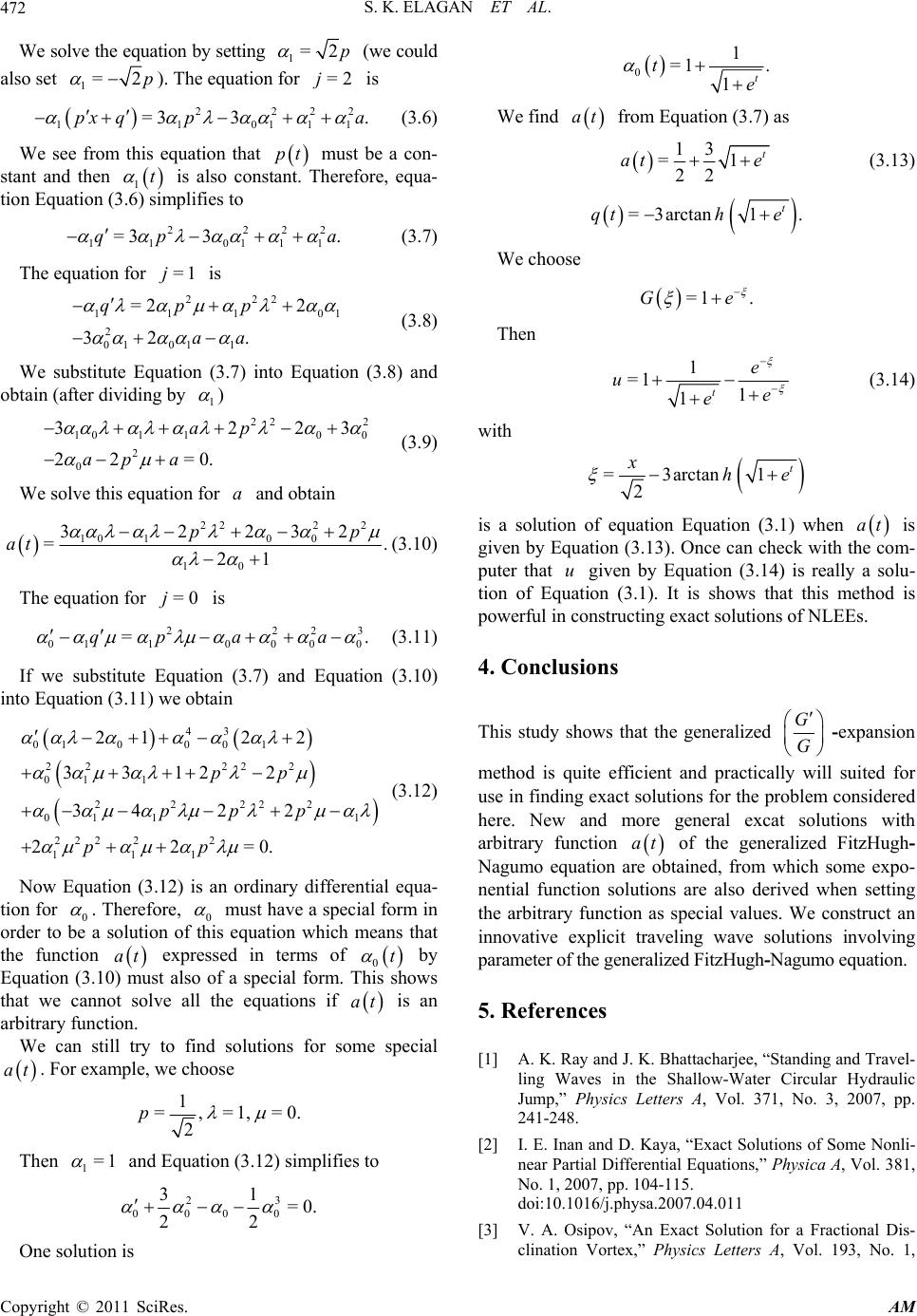 S. K. ELAGAN ET AL. Copyright © 2011 SciRes. AM 472 We solve the equation by setting 1=2p (we could also set 1=2p ). The equatio n f or =2j is 2 222 11 0111 =3 3.px qpa (3.6) We see from this equation that pt must be a con- stant and then 1t is also constant. Therefore, equa- tion Equation (3.6) simplifies to 2 222 1 10111 =3 3.qp a (3.7) The equation for =1j is 222 11101 2 0101 1 =2 2 32 . qpp aa (3.8) We substitute Equation (3.7) into Equation (3.8) and obtain (after dividing by 1 ) 22 2 101 10 0 2 0 3223 22 =0. ap ap a (3.9) We solve this equation for a and obtain 222 2 1010 0 10 32232 =. 21 pp at (3.10) The equation for =0j is 2223 01100 00 =.qp aa (3.11) If we substitute Equation (3.7) and Equation (3.10) into Equation (3.11) we obtain 43 0100 01 2222 2 01 1 22222 01 11 222 22 111 212 2 3312 2 342 2 22=0. pp ppp pp (3.12) Now Equation (3.12) is an ordinary differential equa- tion for 0 . Therefore, 0 must have a special form in order to be a solution of this equation which means that the function at expressed in terms of 0t by Equation (3.10) must also of a special form. This shows that we cannot solve all the equations if at is an arbitrary function. We can still try to find solutions for some special at. For example, we choose 1 =, =1, =0. 2 p Then 1=1 and Equation (3.12) simplifies to 23 0000 31 =0. 22 One solution is 01 =1 . 1t te We find at from Equa tion (3.7) as 13 =1 22 t at e (3.13) = 3arctan1. t qth e We choose =1 .Ge Then 1 =1 1 1t e ue e (3.14) with =3arctan 1 2 t xhe is a solution of equation Equation (3.1) when at is given by Equation (3.13). Once can check with the com- puter that u given by Equation (3.14) is really a solu- tion of Equation (3.1). It is shows that this method is powerful in constructing exact solutions of NLEEs. 4. Conclusions This study shows that the generalized G G -expansion method is quite efficient and practically will suited for use in finding exact solutions for the problem considered here. New and more general excat solutions with arbitrary function at of the generalized FitzHugh- Nagumo equation are obtained, from which some expo- nential function solutions are also derived when setting the arbitrary function as special values. We construct an innovative explicit traveling wave solutions involving parameter of the generalized FitzHugh-Nagum o equation. 5. References [1] A. K. Ray and J. K. Bhattacharjee, “Standing and Travel- ling Waves in the Shallow-Water Circular Hydraulic Jump,” Physics Letters A, Vol. 371, No. 3, 2007, pp. 241-248. [2] I. E. Inan and D. Kaya, “Exact Solutions of Some Nonli- near Partial Differential Equations,” Physica A, Vol. 381, No. 1, 2007, pp. 104-115. doi:10.1016/j.physa.2007.04.011 [3] V. A. Osipov, “An Exact Solution for a Fractional Dis- clination Vortex,” Physics Letters A, Vol. 193, No. 1, 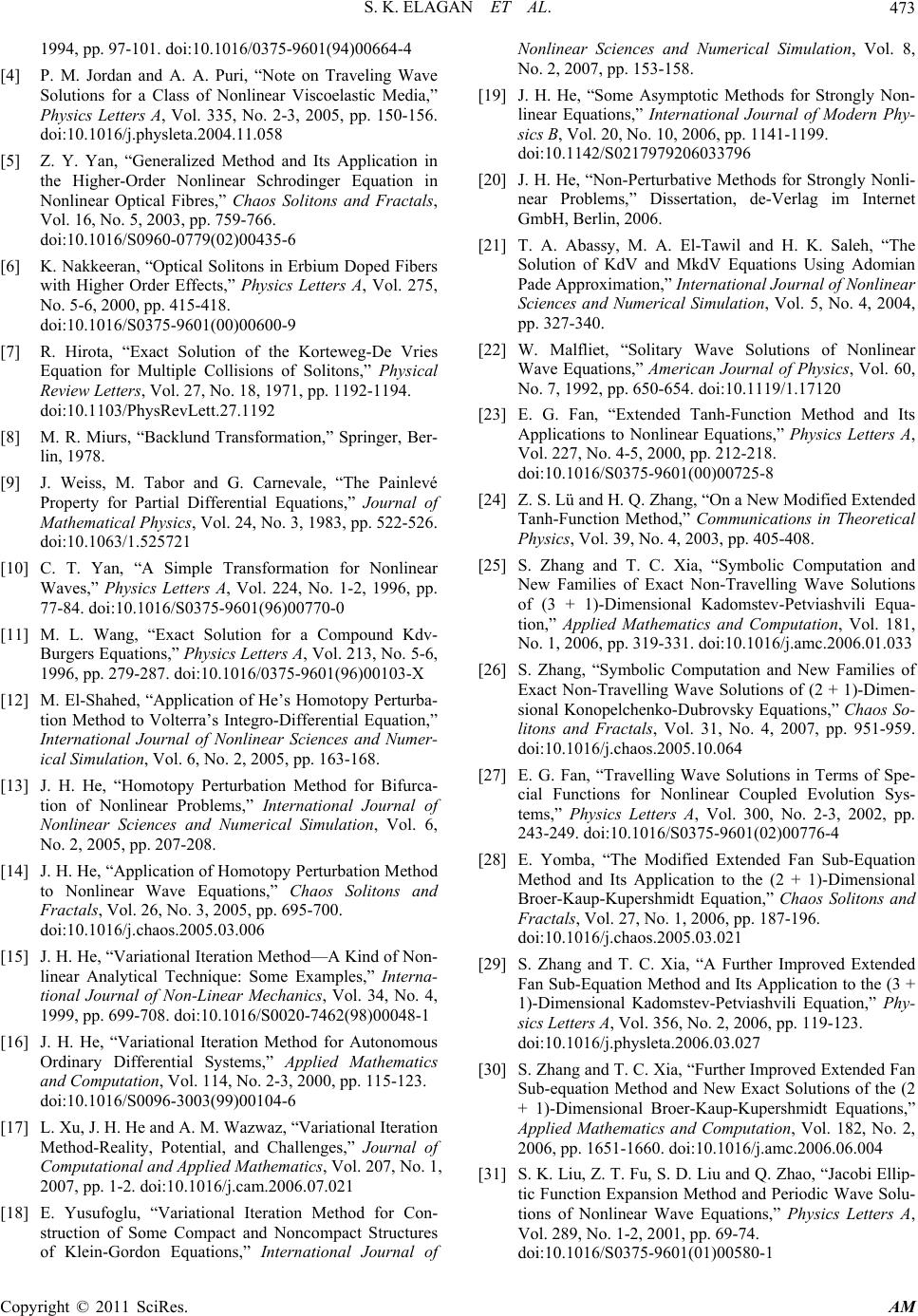 S. K. ELAGAN ET AL. Copyright © 2011 SciRes. AM 473 1994, pp. 97-101. doi:10.1016/0375-9601(94)00664-4 [4] P. M. Jordan and A. A. Puri, “Note on Traveling Wave Solutions for a Class of Nonlinear Viscoelastic Media,” Physics Letters A, Vol. 335, No. 2-3, 2005, pp. 150-156. doi:10.1016/j.physleta.2004.11.058 [5] Z. Y. Yan, “Generalized Method and Its Application in the Higher-Order Nonlinear Schrodinger Equation in Nonlinear Optical Fibres,” Chaos Solitons and Fractals, Vol. 16, No. 5, 2003, pp. 759-766. doi:10.1016/S0960-0779(02)00435-6 [6] K. Nakkeeran, “Optical Solitons in Erbium Doped Fibers with Higher Order Effects,” Physics Letters A, Vol. 275, No. 5-6, 2000, pp. 415-418. doi:10.1016/S0375-9601(00)00600-9 [7] R. Hirota, “Exact Solution of the Korteweg-De Vries Equation for Multiple Collisions of Solitons,” Physical Review Letters, Vol. 27, No. 18, 1971, pp. 1192-1194. doi:10.1103/PhysRevLett.27.1192 [8] M. R. Miurs, “Backlund Transformation,” Springer, Ber- lin, 1978. [9] J. Weiss, M. Tabor and G. Carnevale, “The Painlevé Property for Partial Differential Equations,” Journal of Mathematical Physics, Vol. 24, No. 3, 1983, pp. 522-526. doi:10.1063/1.525721 [10] C. T. Yan, “A Simple Transformation for Nonlinear Waves,” Physics Letters A, Vol. 224, No. 1-2, 1996, pp. 77-84. doi:10.1016/S0375-9601(96)00770-0 [11] M. L. Wang, “Exact Solution for a Compound Kdv- Burgers Equations,” Physics Letters A, Vol. 213, No. 5-6, 1996, pp. 279-287. doi:10.1016/0375-9601(96)00103-X [12] M. El-Shahed, “Application of He’s Homotopy Perturba- tion Method to Volterra’s Integro-Differential Equation,” International Journal of Nonlinear Sciences and Numer- ical Simulation, Vol. 6, No. 2, 2005, pp. 163-168. [13] J. H. He, “Homotopy Perturbation Method for Bifurca- tion of Nonlinear Problems,” International Journal of Nonlinear Sciences and Numerical Simulation, Vol. 6, No. 2, 2005, pp. 207-208. [14] J. H. He, “Application of Homotopy Perturbation Method to Nonlinear Wave Equations,” Chaos Solitons and Fractals, Vol. 26, No. 3, 2005, pp. 695-700. doi:10.1016/j.chaos.2005.03.006 [15] J. H. He, “Variational Iteration Method—A Kind of Non- linear Analytical Technique: Some Examples,” Interna- tional Journal of Non-Linear Mechanics, Vol. 34, No. 4, 1999, pp. 699-708. doi:10.1016/S0020-7462(98)00048-1 [16] J. H. He, “Variational Iteration Method for Autonomous Ordinary Differential Systems,” Applied Mathematics and Computation, Vol. 114, No. 2-3, 2000, pp. 115-123. doi:10.1016/S0096-3003(99)00104-6 [17] L. Xu, J. H. He and A. M. Wazwaz, “Variational Iteration Method-Reality, Potential, and Challenges,” Journal of Computational and Applied Mathematics, Vol. 207, No. 1, 2007, pp. 1-2. doi:10.1016/j.cam.2006.07.021 [18] E. Yusufoglu, “Variational Iteration Method for Con- struction of Some Compact and Noncompact Structures of Klein-Gordon Equations,” International Journal of Nonlinear Sciences and Numerical Simulation, Vol. 8, No. 2, 2007, pp. 153-158. [19] J. H. He, “Some Asymptotic Methods for Strongly Non- linear Equations,” International Journal of Modern Phy- sics B, Vol. 20, No. 10, 2006, pp. 1141-1199. doi:10.1142/S0217979206033796 [20] J. H. He, “Non-Perturbative Methods for Strongly Nonli- near Problems,” Dissertation, de-Verlag im Internet GmbH, Berlin, 2006. [21] T. A. Abassy, M. A. El-Tawil and H. K. Saleh, “The Solution of KdV and MkdV Equations Using Adomian Pade Approximation,” International Journal of Nonlinear Sciences and Numerical Simulation, Vol. 5, No. 4, 2004, pp. 327-340. [22] W. Malfliet, “Solitary Wave Solutions of Nonlinear Wave Equations,” American Journal of Physics, Vol. 60, No. 7, 1992, pp. 650-654. doi:10.1119/1.17120 [23] E. G. Fan, “Extended Tanh-Function Method and Its Applications to Nonlinear Equations,” Physics Letters A, Vol. 227, No. 4-5, 2000, pp. 212-218. doi:10.1016/S0375-9601(00)00725-8 [24] Z. S. Lü and H. Q. Zhang, “On a New Modified Extended Tanh-Function Method,” Communications in Theoretical Physics, Vol. 39, No. 4, 2003, pp. 405-408. [25] S. Zhang and T. C. Xia, “Symbolic Computation and New Families of Exact Non-Travelling Wave Solutions of (3 + 1)-Dimensional Kadomstev-Petviashvili Equa- tion,” Applied Mathematics and Computation, Vol. 181, No. 1, 2006, pp. 319-331. doi:10.1016/j.amc.2006.01.033 [26] S. Zhang, “Symbolic Computation and New Families of Exact Non-Travelling Wave Solutions of (2 + 1)-Dimen- sional Konopelchenko-Dubrovsky Equations,” Chaos So- litons and Fractals, Vol. 31, No. 4, 2007, pp. 951-959. doi:10.1016/j.chaos.2005.10.064 [27] E. G. Fan, “Travelling Wave Solutions in Terms of Spe- cial Functions for Nonlinear Coupled Evolution Sys- tems,” Physics Letters A, Vol. 300, No. 2-3, 2002, pp. 243-249. doi:10.1016/S0375-9601(02)00776-4 [28] E. Yomba, “The Modified Extended Fan Sub-Equation Method and Its Application to the (2 + 1)-Dimensional Broer-Kaup-Kupershmidt Equation,” Chaos Solitons and Fractals, Vol. 27, No. 1, 2006, pp. 187-196. doi:10.1016/j.chaos.2005.03.021 [29] S. Zhang and T. C. Xia, “A Further Improved Extended Fan Sub-Equation Method and Its Application to the (3 + 1)-Dimensional Kadomstev-Petviashvili Equation,” Phy- sics Letters A, Vol. 356, No. 2, 2006, pp. 119-123. doi:10.1016/j.physleta.2006.03.027 [30] S. Zhang and T. C. Xia, “Further Improved Extended Fan Sub-equation Method and New Exact Solutions of the (2 + 1)-Dimensional Broer-Kaup-Kupershmidt Equations,” Applied Mathematics and Computation, Vol. 182, No. 2, 2006, pp. 1651-1660. doi:10.1016/j.amc.2006.06.004 [31] S. K. Liu, Z. T. Fu, S. D. Liu and Q. Zhao, “Jacobi Ellip- tic Function Expansion Method and Periodic Wave Solu- tions of Nonlinear Wave Equations,” Physics Letters A, Vol. 289, No. 1-2, 2001, pp. 69-74. doi:10.1016/S0375-9601(01)00580-1 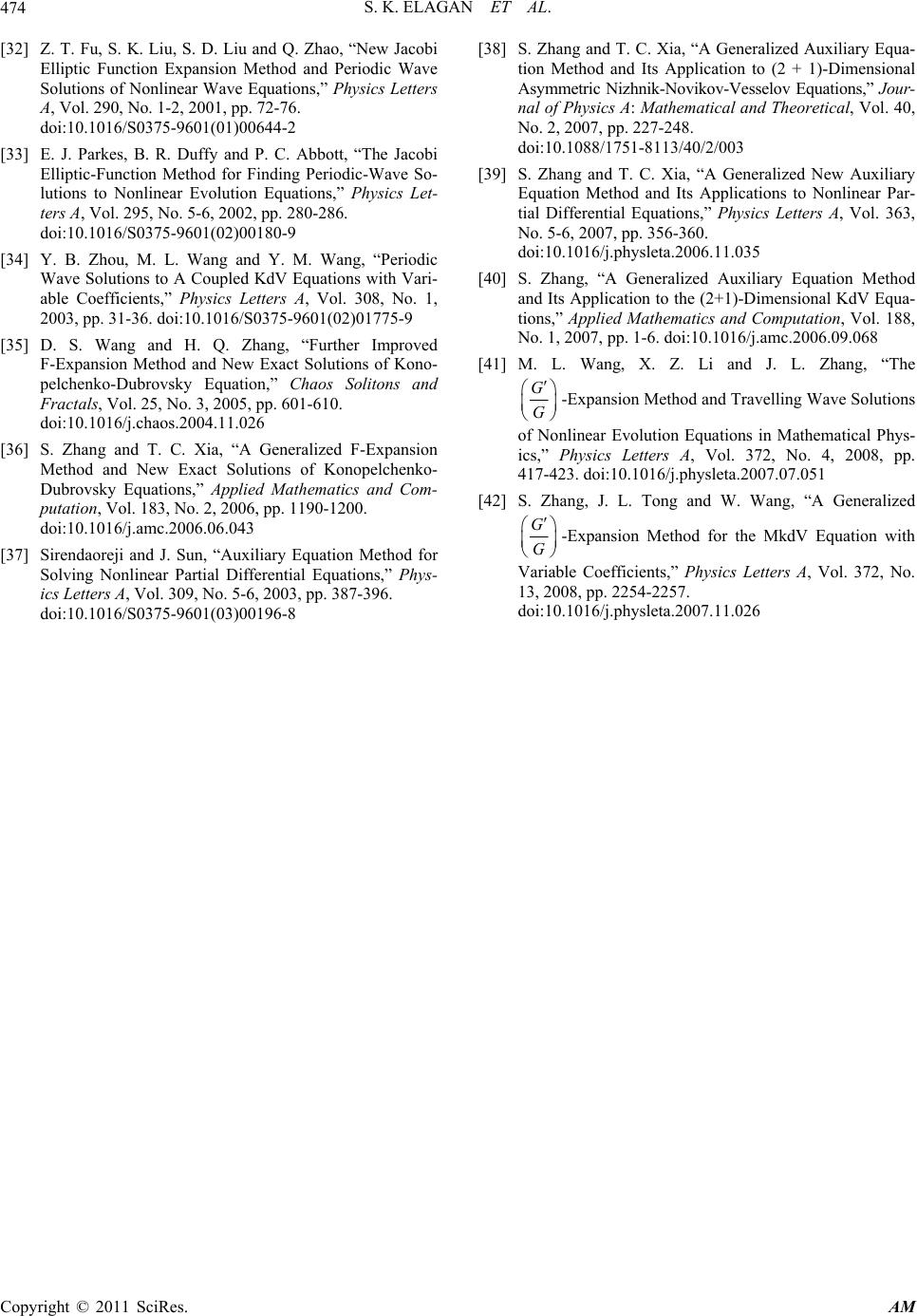 S. K. ELAGAN ET AL. Copyright © 2011 SciRes. AM 474 [32] Z. T. Fu, S. K. Liu, S. D. Liu and Q. Zhao, “New Jacobi Elliptic Function Expansion Method and Periodic Wave Solutions of Nonlinear Wave Equations,” Physics Letters A, Vol. 290, No. 1-2, 2001, pp. 72-76. doi:10.1016/S0375-9601(01)00644-2 [33] E. J. Parkes, B. R. Duffy and P. C. Abbott, “The Jacobi Elliptic-Function Method for Finding Periodic-Wave So- lutions to Nonlinear Evolution Equations,” Physics Let- ters A, Vol. 295, No. 5-6, 2002, pp. 280-286. doi:10.1016/S0375-9601(02)00180-9 [34] Y. B. Zhou, M. L. Wang and Y. M. Wang, “Periodic Wave Solutions to A Coupled KdV Equations with Vari- able Coefficients,” Physics Letters A, Vol. 308, No. 1, 2003, pp. 31-36. doi:10.1016/S0375-9601(02)01775-9 [35] D. S. Wang and H. Q. Zhang, “Further Improved F-Expansion Method and New Exact Solutions of Kono- pelchenko-Dubrovsky Equation,” Chaos Solitons and Fractals, Vol. 25, No. 3, 2005, pp. 601-610. doi:10.1016/j.chaos.2004.11.026 [36] S. Zhang and T. C. Xia, “A Generalized F-Expansion Method and New Exact Solutions of Konopelchenko- Dubrovsky Equations,” Applied Mathematics and Com- putation, Vol. 183, No. 2, 2006, pp. 1190-1200. doi:10.1016/j.amc.2006.06.043 [37] Sirendaoreji and J. Sun, “Auxiliary Equation Method for Solving Nonlinear Partial Differential Equations,” Phys- ics Letters A, Vol. 309, No. 5-6, 2003, pp. 387-396. doi:10.1016/S0375-9601(03)00196-8 [38] S. Zhang and T. C. Xia, “A Generalized Auxiliary Equa- tion Method and Its Application to (2 + 1)-Dimensional Asymmetric Nizhnik-Novikov-Vesselov Equations,” Jour- nal of Physics A: Mathematical and Theoretical, Vol. 40, No. 2, 2007, pp. 227-248. doi:10.1088/1751-8113/40/2/003 [39] S. Zhang and T. C. Xia, “A Generalized New Auxiliary Equation Method and Its Applications to Nonlinear Par- tial Differential Equations,” Physics Letters A, Vol. 363, No. 5-6, 2007, pp. 356-360. doi:10.1016/j.physleta.2006.11.035 [40] S. Zhang, “A Generalized Auxiliary Equation Method and Its Application to the (2+1)-Dimensional KdV Equa- tions,” Applied Mathematics and Computation, Vol. 188, No. 1, 2007, pp. 1-6. doi:10.1016/j.amc.2006.09.068 [41] M. L. Wang, X. Z. Li and J. L. Zhang, “The G G -Expansion Method and Travelling Wave Solutions of Nonlinear Evolution Equations in Mathematical Phys- ics,” Physics Letters A, Vol. 372, No. 4, 2008, pp. 417-423. doi:10.1016/j.physleta.2007.07.051 [42] S. Zhang, J. L. Tong and W. Wang, “A Generalized G G -Expansion Method for the MkdV Equation with Variable Coefficients,” Physics Letters A, Vol. 372, No. 13, 2008, pp. 2254-2257. doi:10.1016/j.physleta.2007.11.026 |

